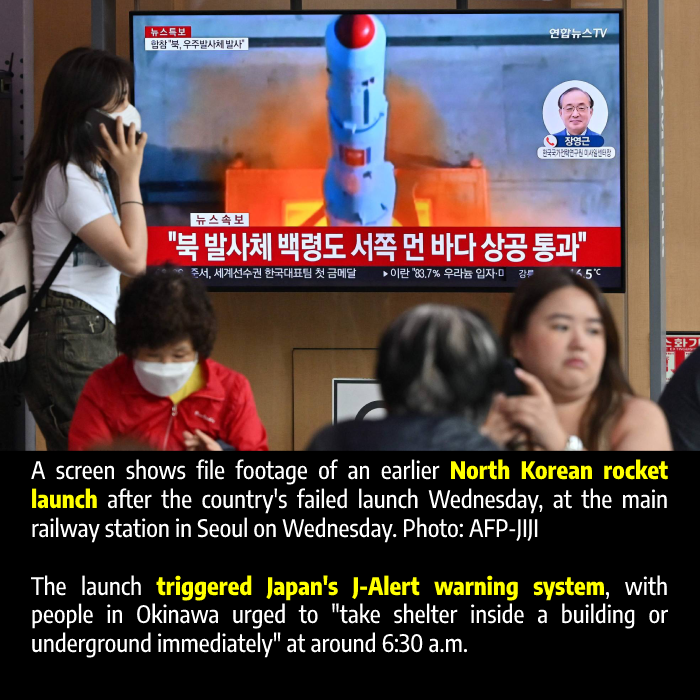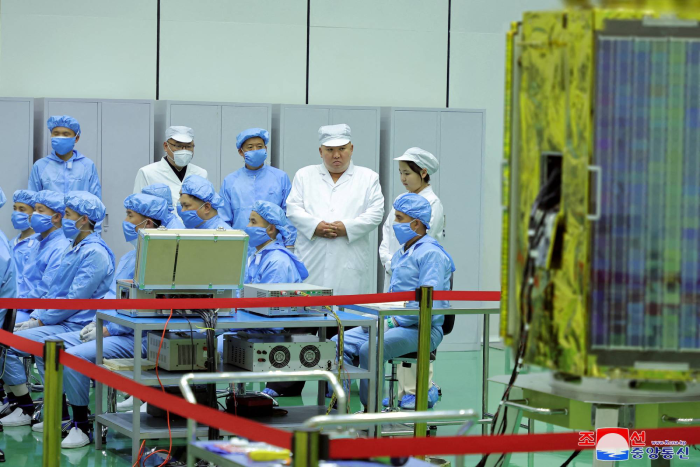By Jesse Johnson.

North Korea attempted to launch a military reconnaissance satellite early Wednesday — briefly prompting Japan to issue an emergency alert for Okinawa Prefecture — but said the rocket had malfunctioned, crashing into the sea shortly after launch.
The new Chollima-1 rocket carrying the Malligyong-1 satellite failed after its first stage separated due to engine problems and “the unstable character of the fuel used,” the North’s official Korean Central News Agency reported.
It said the North would attempt a second launch “as soon as possible.”
The launch triggered Japan’s J-Alert warning system, with people in Okinawa urged to “take shelter inside a building or underground immediately” at around 6:30 a.m. The warning — the eighth time the alert had been issued over a North Korean missile launch — was lifted around 30 minutes later, after the projectile was believed to have already splashed down.
North Korean officials on Monday informed Japan and international authorities of a plan to launch its first military satellite before June 11.
Japan’s top government spokesman, Chief Cabinet Secretary Hirokazu Matsuno, told a news conference later Wednesday that the “apparent ballistic missile” had disappeared from tracking over the Yellow Sea and was not believed to have put any object into orbit.
“North Korea’s actions, including its repeated missile launches, are a threat to the peace and security of our country, the region and the international community,” Matsuno said after a meeting of the National Security Council, adding that Tokyo would respond “in close cooperation with the international community, including the United States and South Korea.”
The U.S. also slammed the launch, calling it a “a brazen violation of multiple U.N. Security Council resolutions” that “raises tensions, and risks destabilizing the security situation in the region and beyond,” National Security Council spokesman Adam Hodge said in a statement.
“This claimed space launch involved technologies that are directly related to the DPRK intercontinental ballistic missile program,” the statement said, using the acronym for the North’s formal name, the Democratic People’s Republic of Korea.
In Seoul, South Korea’s military said the projectile had been fired from Tongchang-ri, on the North’s west coast, falling into waters about 200 kilometers west of the South’s southwestern island of Eocheong. The military said it was attempting to salvage an object believed to be a part of the rocket.
Data provided earlier by the North said the launch path would see the rocket fly south, with various stages and potentially other debris expected to fall over the Yellow Sea, East China Sea and into the Pacific Ocean to the east of the Philippines’ Luzon Island.
Japan had ordered the Self-Defense Forces to prepare to shoot down any North Korean ballistic missile, rocket or debris that threatened Japanese territory — an order similar to one given in February 2016, the last time North Korea tried to put a satellite into orbit, another attempt that was believed to have failed.
Wednesday’s launch also prompted the Seoul city government to erroneously send out an emergency alert advising citizens to prepare to evacuate. Video posted to social media showed sirens blaring in the South Korean capital after the mobile phone alert was sent to all Seoul citizens at 6:41 a.m. But the country’s interior ministry retracted the alert around 20 minutes later, saying it had been sent by mistake.
On Tuesday, a senior North Korean military official said in a statement that the new spy satellite would be “indispensable” for “real-time” tracking and monitoring for Washington and its allies amid a ramped-up pace of joint U.S.-South Korea military drills in recent months, as well as rare trilateral missile-tracking exercises with Japan.
Observers said that the trilateral military cooperation driven by improving ties between Tokyo and Seoul had triggered unease in Pyongyang.
“North Korean officials have accused Seoul and Washington of raising tensions with scaled-up live-fire exercises and a multinational naval drill that includes Japan,” said Leif-Eric Easley, a professor at Ewha University in Seoul. “Pyongyang is concerned that South Korea is successfully deepening trilateral security cooperation with Japan and the United States.”

The plan to put a satellite into orbit — the North’s first space rocket launch in more than seven years — was met with round condemnation, with Tokyo, Washington and Seoul condemning the move as a clear violation of United Nations Security Council resolutions.
Pyongyang is prohibited from conducting ballistic missile launches under UNSC resolutions, but has in the past said these measures do not cover its nominally civilian space program. Japan, South Korea and the U.S., however, view the launch of satellites as a thinly veiled means of advancing its missile program, since similar technology is employed.
But even if the North is ultimately successful in putting a satellite into low-Earth orbit, it would still face a number of daunting challenges, including camera performance, hard-to-come-by components and limited time windows for snapping shots of military sites, according to experts.
In preparation for a potential shootdown of the rocket or debris, Japan has sent PAC-3 ground-based missile-defense batteries to Okinawa’s Miyako, Ishigaki and Yonaguni islands, while also deploying Maritime Self-Defense Force Aegis destroyers — which are equipped with SM-3 interceptors — to waters around Japan.
The MSDF’s Aegis destroyers equipped with SM-3s are designed to shoot down ballistic missiles outside the atmosphere, while the PAC-3 systems — which have a range of 30 kilometers — are used to intercept missiles that evade the SM-3s, and are seen as the last line of defense.
Japanese Defense Minister Yasukazu Hamada told reporters Wednesday that those missile defenses would remain on alert for the time being.
Source: The Japan Times. 31 May 2023